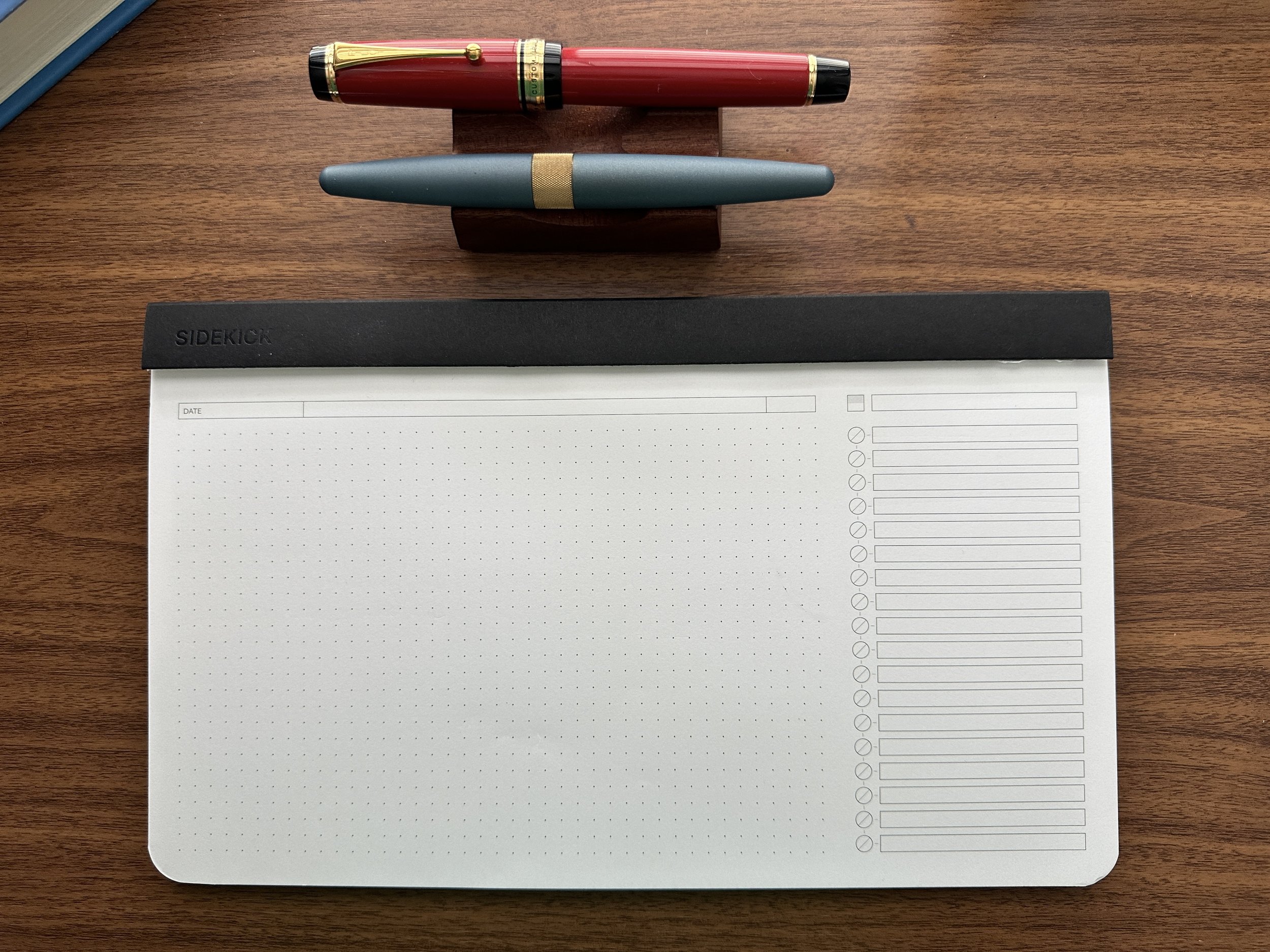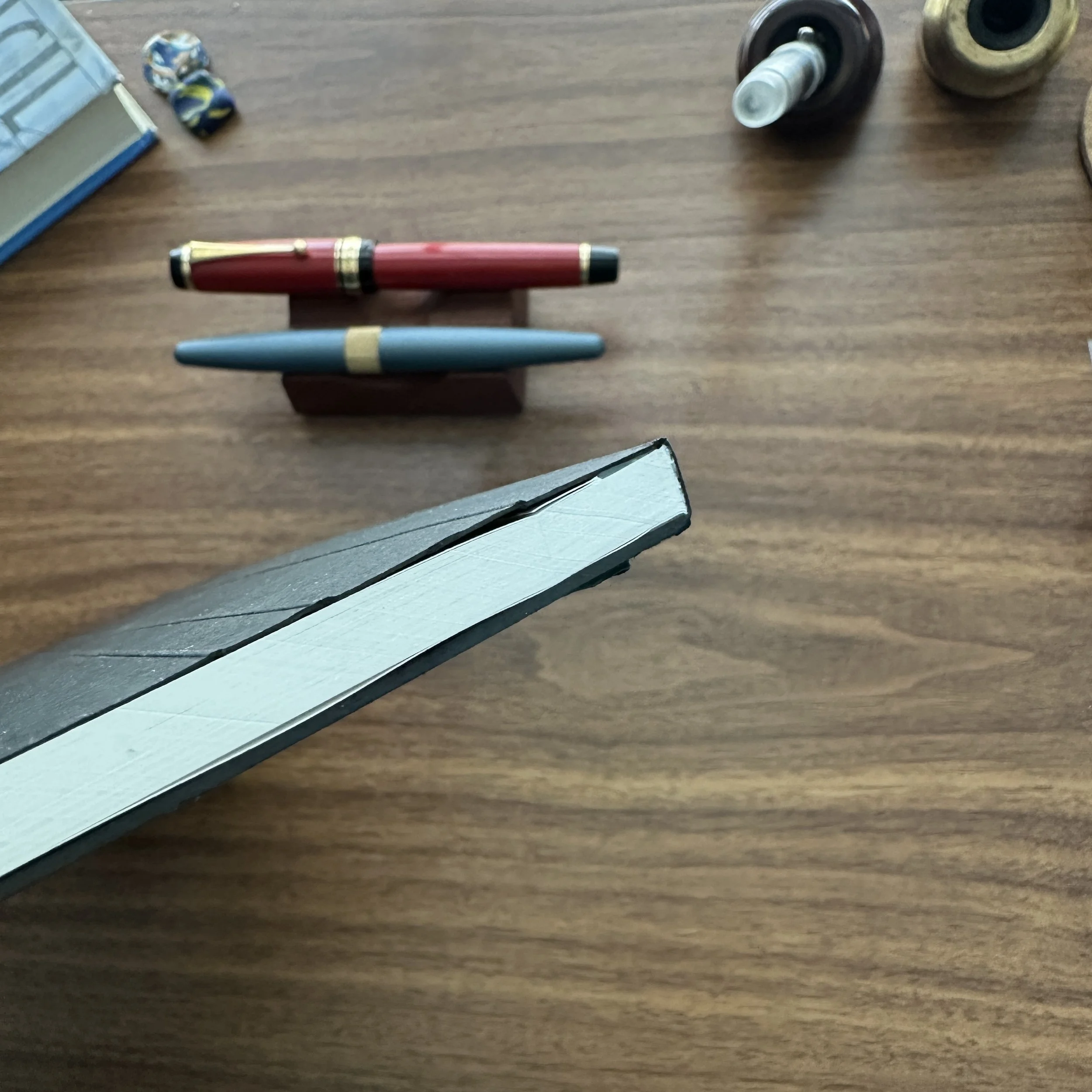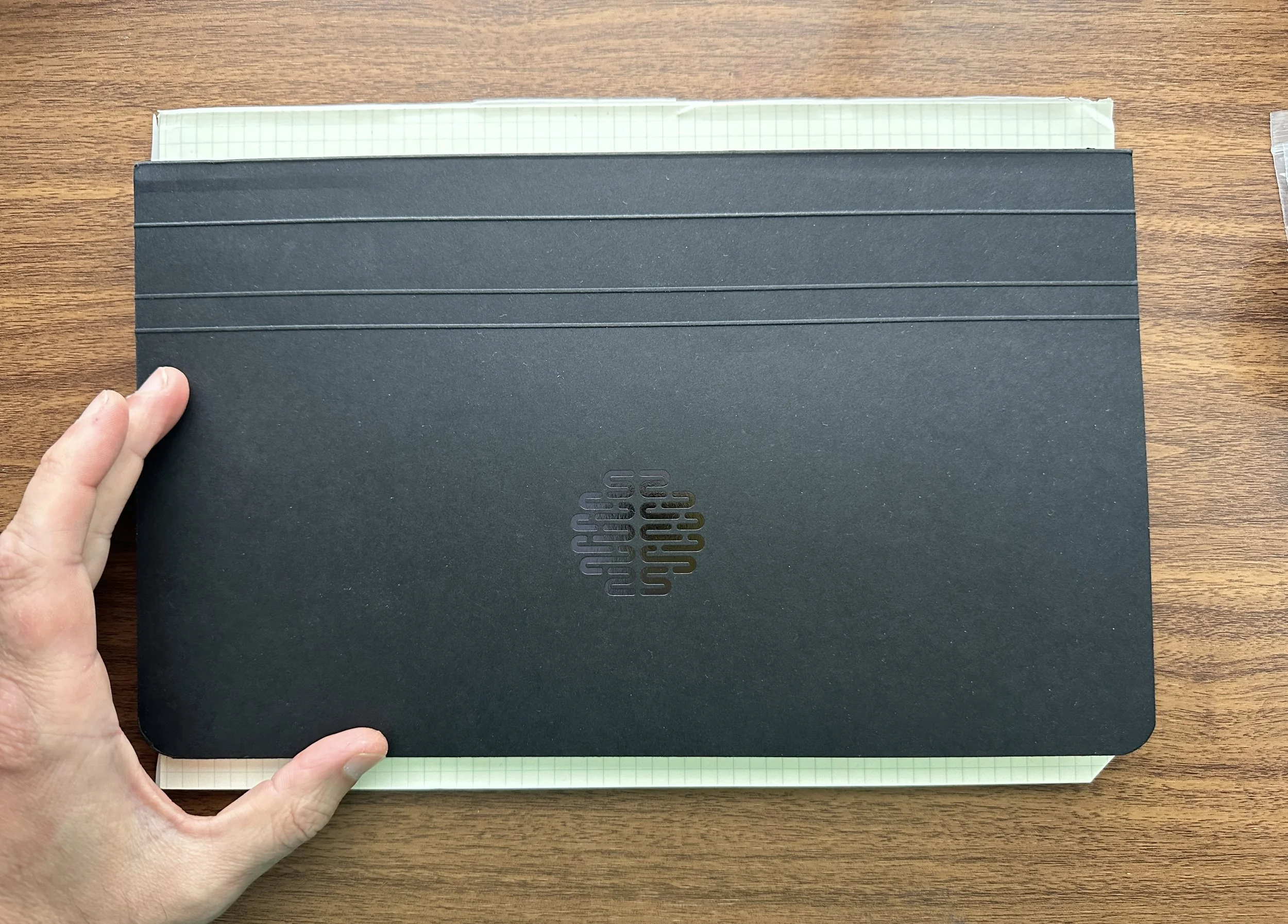Since the release of the Baron Fig Mastermind in 2017, I've paid close attention to the "landscape desk pad" segment of the stationery marketplace, because as I mentioned in my review of that product, this particular category holds a special place in my productivity-stationery-loving heart. There's no set of circumstances under which I don't have a pad of paper sitting below or to the side of my keyboard when I'm working on the computer, and I often prefer a "landscape" (i.e., horizontal) layout when I'm drafting documents longhand. So how does the recently released Sidekick Notepad from Cortex Brand measure up to the significant hype it’s received? Let’s take a look.
The foldover cover, complete with Cortex “Brain” logo.
A Second Original Product from Cortex Brand, an Offshoot of the Cortex Podcast
Rarely does a paper product - much less something like a desk pad - generate significant attention in "mainstream" internet and YouTube circles, but with the release of the Sidekick Notepad, Cortex Brand has achieved just that. Not only am I starting to see this product broadly advertised on social media, but it’s also been reviewed in publications such as Inc. While it may not be “the best productivity tool I’ve used yet” (as Inc. somewhat hyperbolically proclaims), Cortex Brand definitely has something with their stationery product line, and they’ve certainly accomplished their stated goal of designing a product capable of standing alone, independent of a podcast audience. Whether that ends up being the case remains to be seen, but the Sidekick Notepad is a great product that fits a niche many stationery manufacturers have largely ignored.
Those unfamiliar with Relay.fm’s Cortex Podcast but interested in discussions of the intersection between digital and analog in work and everyday life should give Cortex a listen. Hosted by Myke Hurley (of The Pen Addict podcast) and CGP Grey (of the eponymous YouTube Channel), I've been a semi-regular listener for years, and previously reviewed their Theme System Journal, which has been helpful to me at various points over the past few years as I've navigated some life changes which required a more structured journaling experience. The Sidekick Notepad is the second product wholly designed by Cortex Brand, which borrows some visual design elements from the Theme System Journal and generally builds on a common theme of offering products designed to assist users is capturing thoughts and ideas in a structured - but not overly structured - format that helps translate raw material into action items.
I also want to comment on the print quality. The printing on the dot grid and the To-Do list are exceptionally clean and legible.
Layout, Build Quality, and Specific Workflow for Which this Product is Designed
Straddling the line between notebook and notepad, the Sidekick Notepad is a 12 x 7” (roughly A4) covered writing pad that features a dot grid layout with a to-do list column on the right-hand side. The design and build quality is exceptional. Featuring 60 sheets of thick, fountain pen friendly Munken Lynx paper, I've had no issues with fountain pens or rollerballs feathering or bleeding through the pages. The cover is constructed from a paper called "Extract" made from recycled coffee cups, and the entire notepad is hand-assembled by a print shop in London using a combination of modern and traditional techniques. I want to call out three specific points that I believe makes the Sidekick Notepad a well-made stationery product:
The Munken Paper Doesn't Curl. Those of you who regularly use desk and legal pads know what I'm talking about. Over time, resting your arms on the pad and/or carrying them in a briefcase can cause the paper to curl at the edges, resulting in a beat-up look that detracts from an otherwise clean, professional design. That's not a factor with the Sidekick, helped by not only paper quality but the fold-down cover.
The Perforations Tear Easily and Cleanly. This one's self-explanatory, but it's a big deal to me. I dislike desk pads and legal pads with messy perforations that leave bits of torn paper stuck to the top of the binding.
The Cover Looks Professional and Is Sturdy Enough to Travel. I love the Baron Fig Mastermind, but my major complaint is that it's hard to transport the pad in a briefcase between locations without the paper getting torn to shreds and bent. There’s also a flimsy backing board so the entire pad tends to curl over time. The Sidekick Notepad solves this problem by adding a durable cover that folds back underneath the pad when in use, as well as a sturdy backing board that keeps the pad flat and should hold up to a significant amount of daily use. This sort of durable construction is a major value-add for me, and what may keep me using this product going forward.
Check out the perforations! I also like the subtle branding.
How is this product intended to be used? Based on both the layout and the explanation given on several different episodes of Cortex, the natural use case is as a GTD-style capture device. The Sidekick Notepad sits beneath your keyboard (or in front of you at a meeting), and as you jot notes you further refine them into to-dos and action items that you can then incorporate into your bullet journal or digital to-do manager. It's a clean, straightforward workflow. While you can also use the Sidekick for standard notetaking or writing, you'll probably want to seek out something slightly more cost-effective, as I'll discuss below.
A huge part of the Sidekick’s allure is its aesthetic, as well as the functionality. Not only does the cover protect your notepad and add a layer of privacy if you want to cover your writing during meetings or when you step away from your desk (a big plus for me), it just looks better as it’s used compared to other pads that can start to seem tattered after they’ve been used for a while.
Price: At $35 (Before Shipping), the Sidekick Notepad May Be Prohibitively Expensive for Some
A large section of this review has to be devoted to the price point at which Cortex Brand sells this product, because the main drawback is expense. The Sidekick Notepad costs $35 for one notebook, with shipping for a single notebook costing an additional $10-15. Cortex Brand uses Cotton Bureau for fulfillment, which results in a somewhat incongruous situation where a product made in the U.K. is shipped to the U.S. for fulfillment, and U.K./European customers bear the brunt of international shipping on a U.K.-made product. I will note that, at least for U.S. consumers, purchasing this product in bulk evens out the shipping. Ten notebooks currently results in a shipping charge of $16.74 (more than reasonable), which brings the per-unit price (shipped) to roughly $36.60 - expensive, but hardly unprecedented given the prices enthusiasts pay for Japanese brands such as Life Stationery. The larger question is whether NON-stationery nerds (i.e., just regular nerds and professionals) who aren’t already Cortex fans will pay this much for a disposable writing pad that’s NOT intended to be retained long-term, and whether the reason for the price point is adequately communicated outside the Cortex Podcast audience.
The specifications on the notebook are high quality, and it shows once you have the product in hand.
In addition to discussing the demanding product specifications and lengthy design/prototyping process, on the podcast Myke and Grey talk about how they are trying to create a company targeting consumers beyond those who already listen to the Cortex Podcast. While they have absolutely nailed the design and build quality, the primary roadblock to the Sidekick Notepad achieving true "mainstream" success outside the Cortex listenership is that you have to listen to the podcast to fully appreciate what they were trying to accomplish. You can’t really evaluate the Sidekick as “just a notepad,” but rather as a tool that’s intended to be used in a specific way.
I’ve had no issues using fountain pens on either the Sidekick Notepad or in the Theme System Journal. I love this paper and would like to see it used more.
Personally, prior to listening to two different Cortex episodes discussing the Sidekick Notepad, I had passed on purchasing and reviewing this product. A long-time friend and reader asked me to reconsider, and was kind enough to send me one of the multiple Sidekicks she had purchased. The fact that someone was enthusiastic enough about the item to not only buy multiples but to donate one so that it could be reviewed was the first factor that caused me to reconsider my position here. My perspective further changed after I was actually able to hear the story and philosophy behind the product, and understand that it would supplement, not replace, certain items already in my workflow.
The backing board is substantial and durable, something that’s not as common as you might think but adds a lot of value to the quality of the experience.
Takeaways and Where to Buy, Along with A few less costly Alternatives
As noted, you can purchase the Sidekick Notepad via Cotton Bureau for $35. I enjoy this product and will probably pick up a few more, especially since at some point I will be placing a reorder for the Theme System Journal, and one of the Cortex Brand Mark One pens. It of course helps that the Sidekick's layout fits nicely with how I already take notes at my computer, and my own work situation (moving between setups at home and in a physical office). At $35 per unit, the Sidekick will be price prohibitive for certain consumers - especially those who don't want/need the note + action item layout - but understanding the product's intended audience and use-case, a market for a high-end notepad like this one definitely exists.
Slimmer than most, the Sidekick Notepad will fit beneath a keyboard and will be versatile enough to use in most locations. Shown here atop a standard A4 Midori MD Writing Pad.
Who is this product NOT for? Those who burn through 5+ sheets of paper on a daily basis, or who only use desk pads for taking lots of notes and drafting documents. If you're someone who prefers (or is required) to retain notes long-term, you might consider a spiral bound landscape notebook like those sold by Write Notepads or Maruman Mnemosyne, both of which contain fountain pen friendly paper and are generally less expensive. Those looking for a more straightforward tear-off writing pad without the special formatting can get a similar experience from the Baron Fig Mastermind, or a Midori MD or MD Cotton writing pad, again at a lower per-unit price. It goes without saying that none of these products are "cheap" by any stretch - if you appreciate quality paper, you'll need to pay for it, as these days good stationery is simply not made in the quantities necessary to keep prices at a commodity level.
The Gentleman Stationer is supported entirely by purchases from the T.G.S. Curated Shop and pledges via the T.G.S. Patreon Program. This product was donated by a reader for review and was not funded or sponsored by Cortex Brand. This post does not contain links to affiliates or third-party advertisers.


